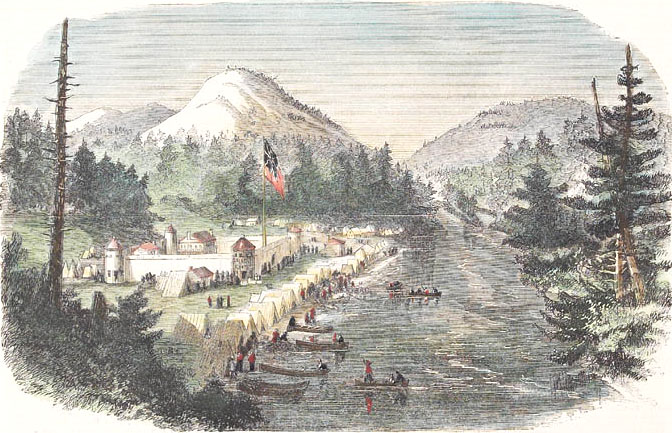
The Monashee Almanac is an online journal that shares history, mysteries and stories about early British Columbia and in particular the Monashee, Okanagan and Shuswap.
Celebrating History, Mysteries & Stories
A letter in the Times from Victoria, Vancouver's Island, dated Jan. 20, gives a good deal of information relative to the gold districts. The writer begins by referring to the Fraser River, the main artery of the auriferous region:--
The south branch of the Fraser has its sources
near Mount Brown, in the Rocky Mountains,
in about 53 deg. North latitude,
118 deg. 40 min. west longitude.
Thence this branch flows for 200 miles to Fort George, a post of the Hudson's Bay Company. The north branch rises in an opposite direction, It receives its supply from a series of lakes lying between 54 deg. And 55 deg. Of north latitude, longitude about 124 deg. 50 min. west, and runs a course of 260 miles to its junction with the south branch, some miles below the 54th parallel of north latitude. Here the union of the two branches forms the Fraser River proper.
Adding the north branch, which is also a gold-bearing stream, and which was worked last season, to the other arm, the two will give us a continuous stretch of auriferous riverain territory upwards of 1000 miles in length, extending for many miles back into the country on both sides, but not including the tributary rivers which fall into the Fraser. In short, the river itself is now known to be auriferous, and to pass through a gold-bearing country throughout its whole course. Gold is also found in most of the tributaries of the Fraser, of which no less than fifty-nine are know. The great length of the main river and the number of its tributaries will give some idea of the auriferous resources of the country.
But these facts do not by any means convey a comprehensive or accurate view of the vast extent of the area of the goldfield, because they are limited to the central portions of the country, while the whole of the upper portion of British Columbia, from its southern to its northern boundary, is auriferous.
Besides the gold found in the beds and on the shores of these streams, the Fraser itself and many of its tributaries are skirted or bordered by terraces, all which yield gold also. These terraces, or benches, as the miners call them, run at intervals along both sides of the rivers for miles in length; and they recede, where the mountains retire, for distances back into the valleys, varying from a few acres to a few miles in breadth.
They are objects of curiosity and speculation, and add much to the beauty of the rude scenes in which they occur from the regularity and evenness of their structure. They generally occur on both sides of the river (opposite to each other), at the same place, sometimes at the same elevations on both sides, sometimes at different elevations, high on this and low on the other side of the river; and in some places they are multiplied into several successive level parallel plateaux, rising one above the other as they recede from the bank.
These terraces contain vast deposits of gold; and to be worked to advantage the bench diggings must command a stream of water supplied from a source higher than their own surfaces, so as to give a fall to enable the miner to apply the water to the face of the "bench" by a hose. The force of the stream is due to the height of the fall. A good strong stream playing upon the face of the hill will disintegrate a great quantity of "pay dirt" in a short time. The floating rubbish, or "dirt," is caught in a long sluice at the base, provided with "riffles" on the bottom, and spread with quicksilver to catch the gold. This mode of mining is called by the miners "hydraulic mining." Such is the wealth of Cariboo that no quicksilver was used, for the miner could afford to lose all the "fine dust" and to be satisfied with the "lumps."
Apropos to the subject of river mining, I would notice the remarkable fact that the streams which flow from the east are observed to be all auriferous, while those which run from the west are not so. Does this distinction prove that the source of a all the gold spread over the goldfield is in the Rocky Mountains?
The circumstance lends feasibility to this theory, and it is strengthened by the discovery of gold on the east side of the Rocky Mountains in rivers which take their rise in the same chain, but at the opposite side. You are aware that gold is worked on the Saskatchewan, the sources of which are not very far from those of the Fraser. We have also late information of the finding of gold on Peace River, which has its source also in the Rocky Mountains. We are informed that Peace River country contains silver and other ores-a specimen of one of which goes to the exhibition.
The Gold Diggings
of British Columbia
From Illustrated London News, March 29, 1862.

Fort Yale on the Fraser River during the early 1860's